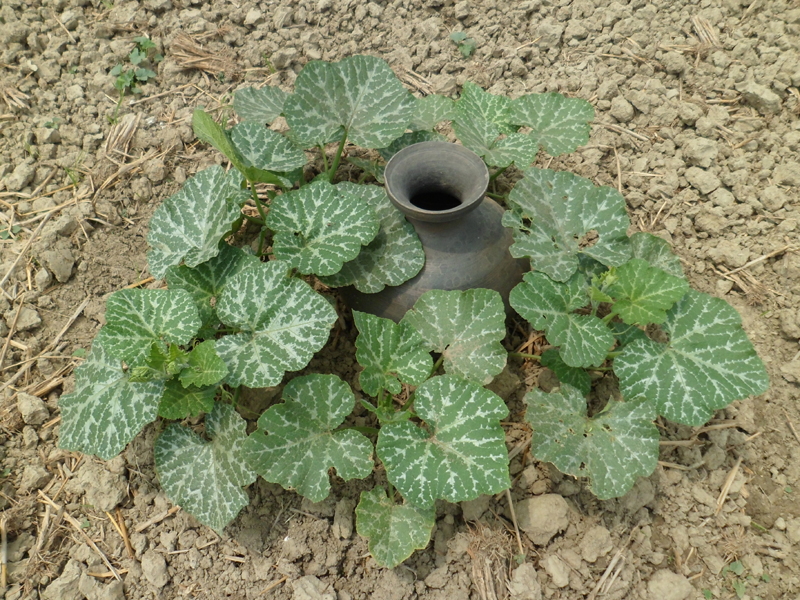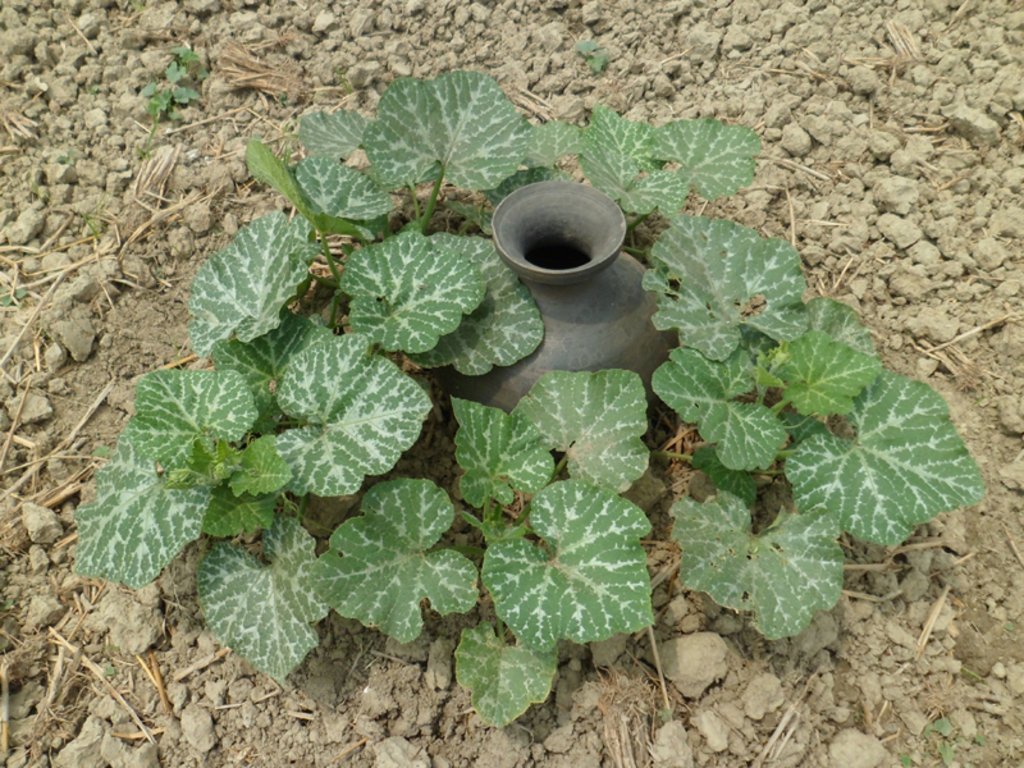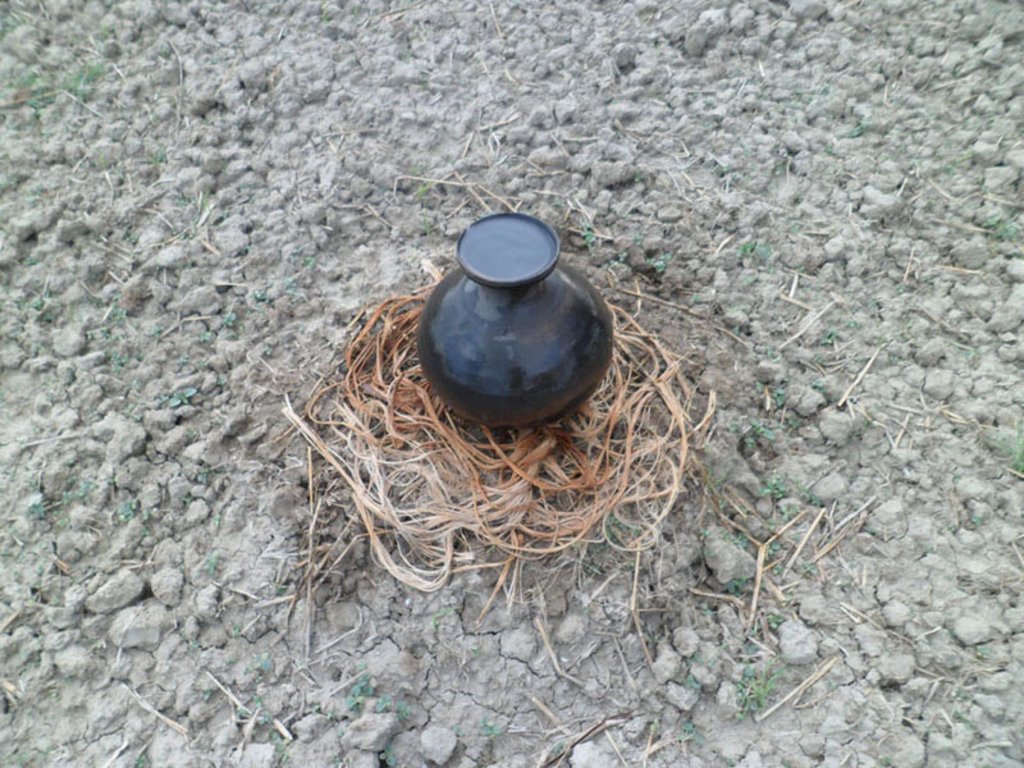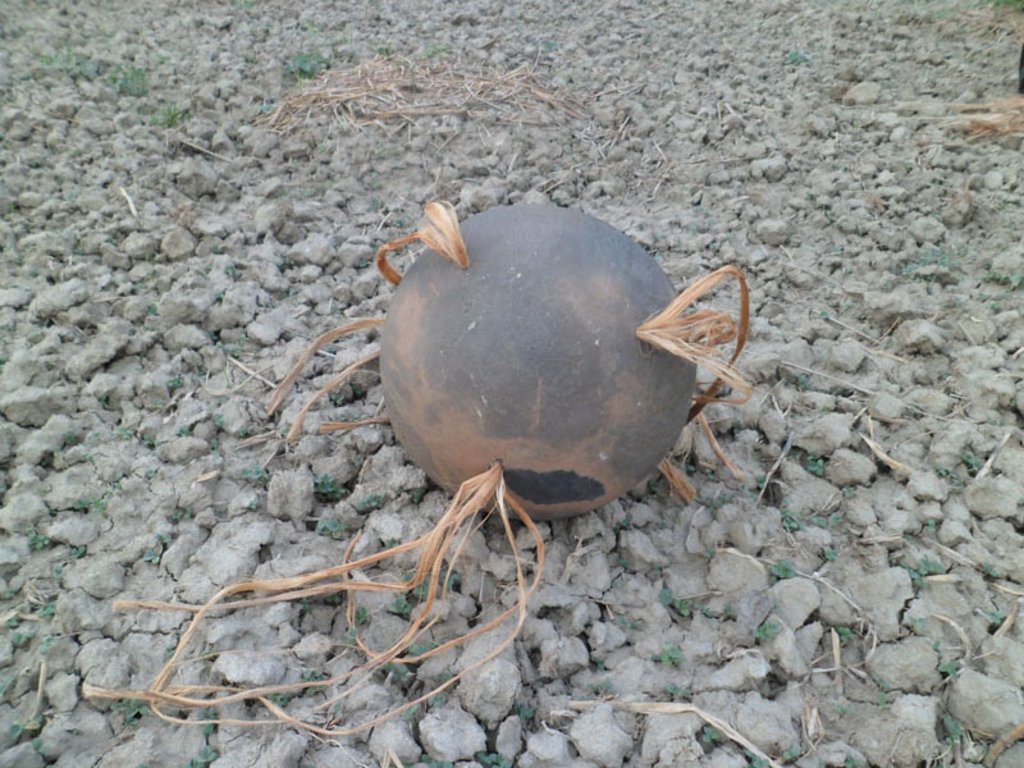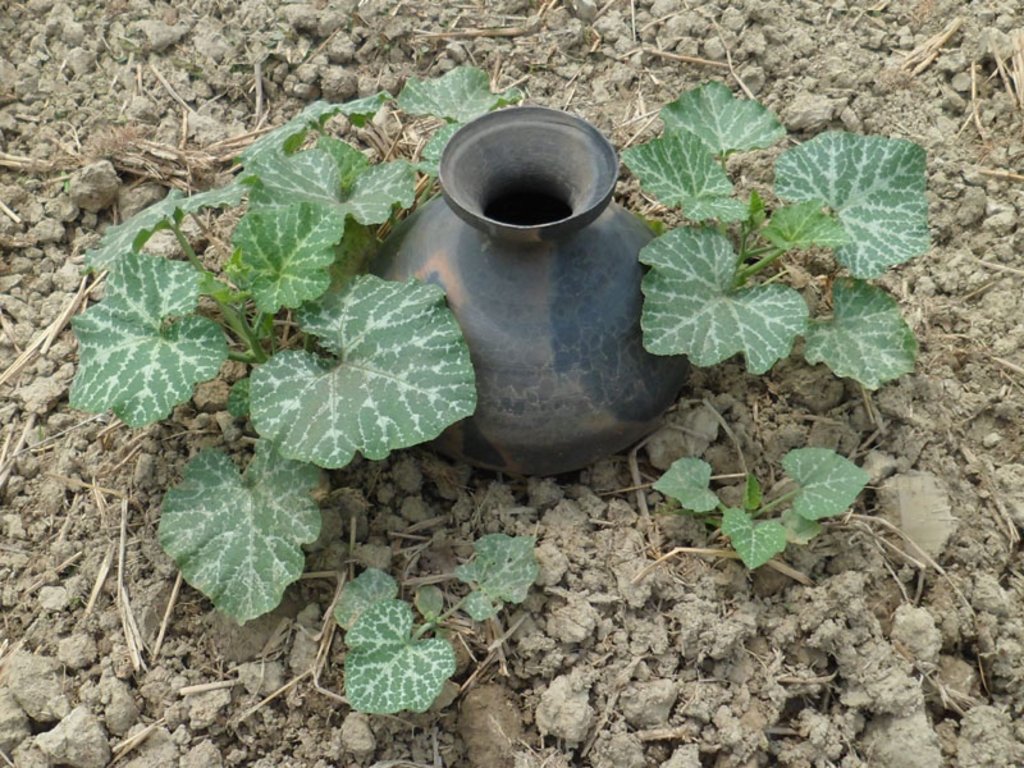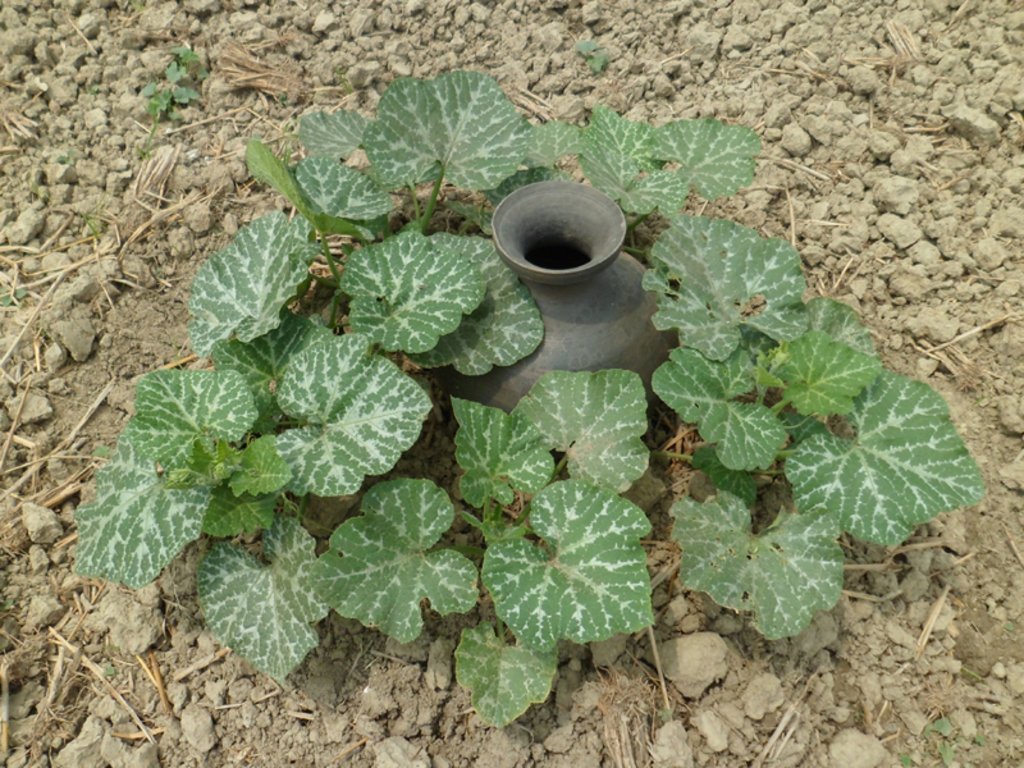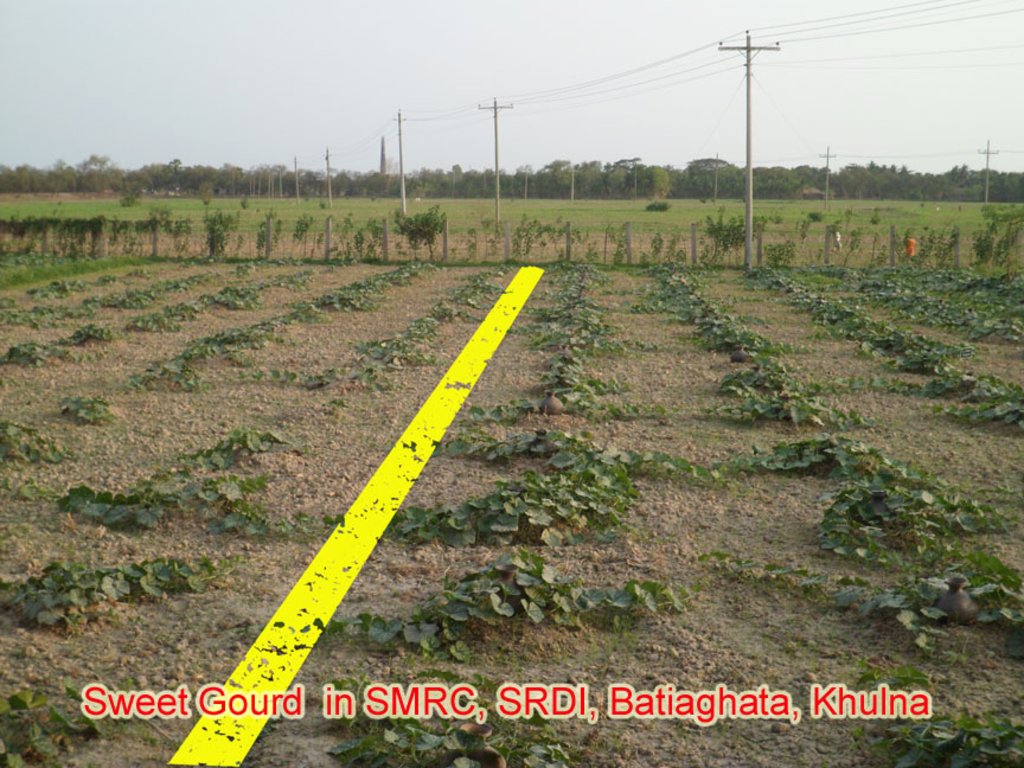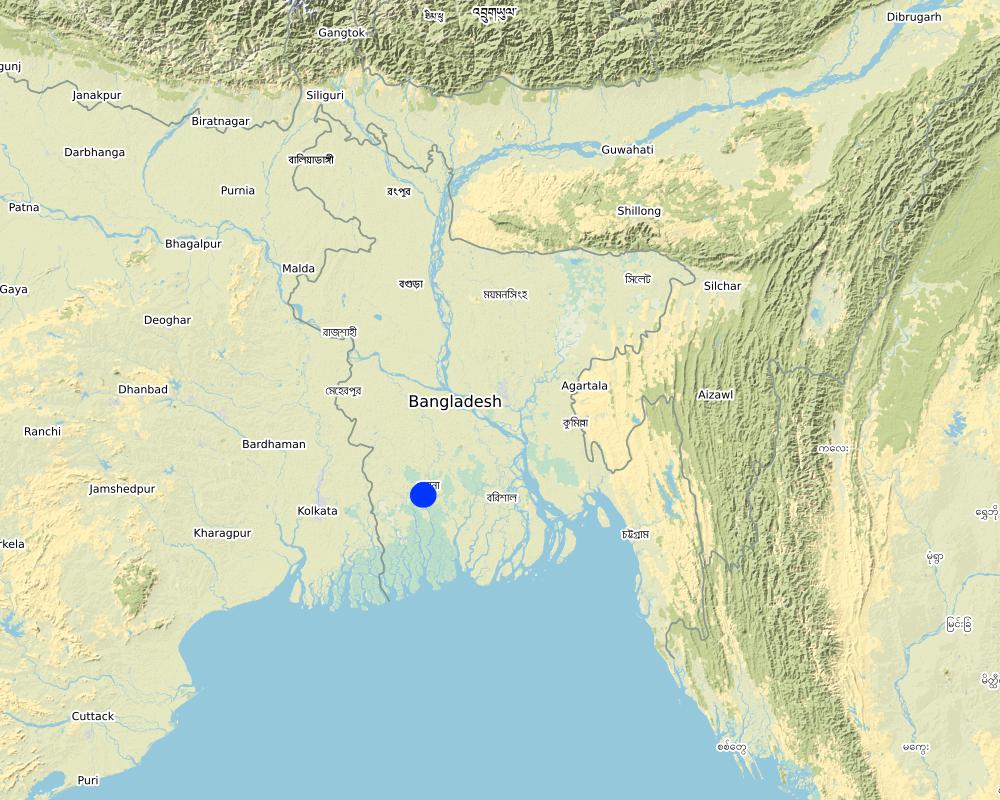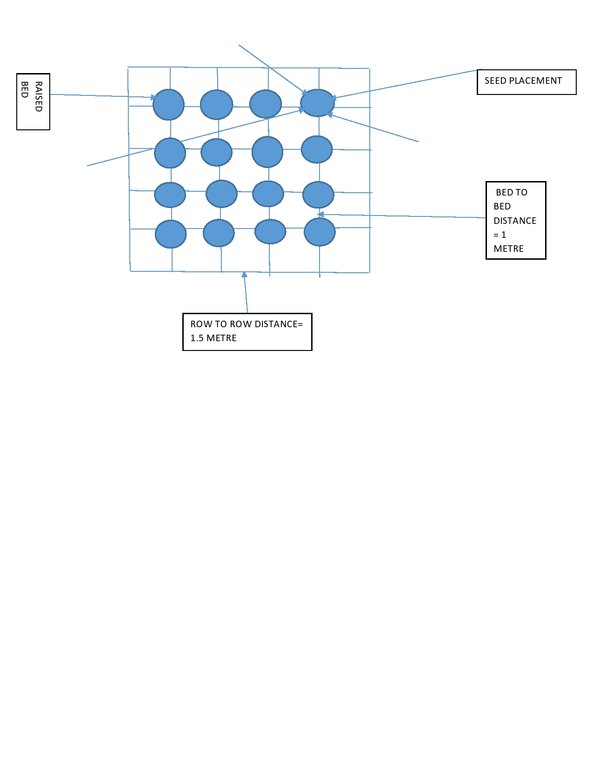Pitcher irrigation for the management of moderately saline soils [孟加拉国]
- 创建:
- 更新:
- 编制者: Md Babul Hossain
- 编辑者: –
- 审查者: Udo Höggel
Kalash shesh podhothi
technologies_4112 - 孟加拉国
查看章节
全部展开 全部收起1. 一般信息
1.2 参与该技术评估和文件编制的资源人员和机构的联系方式
SLM专业人员:
Biswas Sachindranath
+8801718691666
Soil Resource Development Institute
Principal scientific officer, Soil Resource Development Institute, Regional office, khulna
孟加拉国
SLM专业人员:
Biswas Amarendra Nath
+8801718732843
Soil Resource Development Institute
Senior Scientific Officer, Soil Resource Development Institute, Regional Office, Khulna.
孟加拉国
co-compiler:
Zahid Ameer M.D.
8801552409934
zahidsrdi@yahoo.com
Soil Resource Development Institute
Soil Resource Development Institute, Head Office, Farmgate,Dhaka-1215
孟加拉国
有助于对技术进行记录/评估的项目名称(如相关)
Decision Support for Mainstreaming and Scaling out Sustainable Land Management (GEF-FAO / DS-SLM)有助于对技术进行记录/评估的机构名称(如相关)
Soil Resource Development Institute (SRDI) (Soil Resource Development Institute (SRDI)) - 孟加拉国1.3 关于使用通过WOCAT记录的数据的条件
(现场)数据是什么时候汇编的?:
14/2/2017
编制者和关键资源人员接受有关使用通过WOCAT记录数据的条件。:
是
1.4 所述技术的可持续性声明
这里所描述的技术在土地退化方面是否存在问题,导致无法被认为是一种可持续的土地管理技术?:
否
注释:
Pitcher irrigation technique is very effective to check the salinity development on the soil surface through capillary pores in dry season ( November to May ) in salt affected coastal area of Bangladesh.
2. SLM技术的说明
2.1 技术简介
技术定义:
The technology is called pitcher irrigation technology because irrigation water is provided from an earthen pitcher which has several small holes on its bottom. The earthen pitcher is placed on a raised bed which is filled with fresh irrigation water having several pores on its bottom. Then jute fibres are entered into the pores.Then, the pitchers are filled with fresh irrigation water to reduce soil salinity, increase irrigation water use efficiency, increase land cover as well as soil productivity. The technology is popular in case of vegetable cultivation in moderately salt affected area in Bangladesh.
2.2 技术的详细说明
说明:
Agriculture is a major sector of Bangladesh's economy and the coastal area of Bangladesh is suitable for growing rice. More than 30% of the cultivable land in Bangladesh is in the coastal area. Out of 2.86 million hectares of coastal and off-shore lands, about 1.056 million ha of arable lands are affected by varying degrees of salinity. Farmers mostly cultivate low yielding, traditional rice varieties during wet season. Most of the land remain fallow in the dry season (January- May) because of soil salinity, lack of good quality irrigation water and late draining condition ( Karim et al., 1990; Mondal,1997 and SRDI, 2001). Crop production of the salt affected areas in the coastal regions differs considerably from non saline areas. Because of salinity, a special environmental and hydrological situation exists, that restricts the normal crop production throughout the year. In the recent past, with the changing degree of salinity of some areas due to further intrusion of saline water from the sea, normal crop production becomes very risky. Crop yields, cropping intensity, production levels and people’s quality of livelihood are much lower than that in other parts of the country, which have enjoyed the fruits of modern agriculture technologies based on high-yielding varieties, improved fertilizer and water management and improved pest and disease control measures ( BBS, 2001). At the same time food demand in the area is increasing with the steady increase in human population.
In this circumstances, Salinity Management and Research Centre( SMRC) of the Soil Resource Development Institute, located in Batiaghata, Khulna has developed some technologies which can reduce soil salinity, increase irrigation water use efficiency, increase land vegetative cover as well as soil productivity. Now the pitcher irrigation technology is popular in Khulna, Satkhira and Bagherhat districts of Bangladesh.
In this irrigation method, at first, several pores ( 2.2 mm in diameter) are made on the bottom of an earthen pitcher. Then, some jute fibres ( 30 cm long) are entered into the holes keeping 20 cm outside of the pitcher. After that, the pitcher is placed on a raised bed and fill it up with fresh water. Some seed / seedlings (Lagenaria siceraria, Solanum spp, Abelmoschus esculentus, Cucumis sativus, Benincasa hispida) are sown on different corners of the raised bed. It is done before setting the pitcher on the bed. Then water comes out / seeps very slowly through the fibres. It has several benefits as concerns the scientific point of view. First of all, it reduces irrigation water loss at least 70% as compared to flood irrigation due to reduced run off and evaporation . It supplies irrigation water continuously at the surface of the plant bed and rootzone of the crops. The pitcher needs to be refilled at 15 days interval. As a result, the salt movement is hampered / hindered to rise to the surface through capillary pores because of continuous drip irrigation. So, salinity level in the soil doesn't increase throughout the cropping season. Secondly, this technology enhances the seed germination percentage and creates a favourable environment for uptaking soil nutrient by plants and increasing the crop yield.
The farmers responded quickly to adopt the technology, because thousand hectares of land remain fallow in coastal areas in the dry season. During this period, there are two major problems: soil salinity, water salinity and scarcity of suitable irrigation water. The pitcher irrigation technology is playing an important role to reduce soil salinity as well as increasing the efficiency of irrigation and increasing crop yield.
2.3 技术照片
2.5 已应用该技术的、本评估所涵盖的国家/地区/地点
国家:
孟加拉国
区域/州/省:
Khulna region
有关地点的进一步说明:
The region consists of Bagerhat, Satkhira, Khulna, Jessore and Kustia districts.
Map
×2.6 实施日期
如果不知道确切的年份,请说明大概的日期:
- 不到10年前(最近)
2.7 技术介绍
详细说明该技术是如何引入的:
- 在实验/研究期间
3. SLM技术的分类
3.1 该技术的主要目的
- 改良生产
- 减少、预防、恢复土地退化
- 保护生态系统
- 保持/提高生物多样性
- overcome soil salinity
3.2 应用该技术的当前土地利用类型

农田
- 一年一作
主要农作物(经济作物及粮食作物):
Bottle gourd, sponge gourd, okra, indian spinach, cucumber, ash gourd, sweet gourd etc.
3.3 有关土地利用的更多信息
该技术所应用土地的供水:
- 混合雨水灌溉
每年的生长季节数:
- 2
具体说明:
Rainfed rice - vegetables
3.4 该技术所属的SLM组
- 改良的地面/植被覆盖
- 灌溉管理(包括供水、排水)
- Mitigate soil salinity
3.5 技术传播
具体说明该技术的分布:
- 适用于特定场所/集中在较小区域
注释:
Pitcher irrigation technology is being used in moderately saline soil areas. In case of extreme salinity, it cannot reduce the salinity to an optimal level.
3.6 包含该技术的可持续土地管理措施

结构措施
- S4:平沟、坑
注释:
Instead of flood irrigation, controlled irrigation (pitcher irrigation) has been used in coastal areas of Bangladesh to keep moderate soil salinity in check.
3.7 该技术强调的主要土地退化类型

化学性土壤退化
- Cs:盐化/碱化

生物性退化
- Bc:植被覆盖的减少
- Bh:栖息地丧失
3.8 防止、减少或恢复土地退化
具体数量名该技术与土地退化有关的目标:
- 减少土地退化
- 适应土地退化
4. 技术规范、实施活动、投入和成本
4.1 该技术的技术图纸
4.2 技术规范/技术图纸说明
Common sized pitchers (15 litre) have to be collected. At their bottom, 5-6 holes will be made in the form of ballpoint pens (circumference at approximately 2.2 cm). Thereafter, strings of jute fibre (30 centimetre long) will be inserted into the holes. After that, the earthen pitcher will be placed in the raised soil bed (diameter 40 centimetres) in such a way that the holes and jute fibers remain in contact with the soil. Thereafter, 4 seeds should be sown on the 4 corners of the raised bed . The seeds so sown will germinate easily due to moist soil. The jute attached to the holes of the pit will allow water to infiltrate the soil so enable water supply at the root zone of the plants. The mada (raised soil bed) will always be wet. As a result, salt water from the ground level will not come up to the soil surface, thereby preventing the soil salinity in the mada (raised soil bed) area from increasing. Besides, the plants will be able to get adequate water and plant nutrients. Majaor elements of the technology are:
A large size pitcher( 15 litre water holding capacity)
5-6 pores of approx. 2.2 cm diameter are drilled into the bottom of the pitcher
Jute fibres of 30 cm length
Pitcher placed in the middle of the bed (Mada)
4 seeds are sown in the 4 corners of the bed
Salinity reduces: 2.0-2.5 dS/metre
Water requirement: 3-4 filled pitcher amount to complete a crop( Vegetable) life cycle. The irrigation water will be used only in the raised soil bed not in the whole field.
4.3 有关投入和成本计算的一般信息
具体说明成本和投入是如何计算的:
- 每个技术区域
注明尺寸和面积单位:
1 bigha
如果使用本地面积单位,请注明换算系数为1公顷:
0.134 hectare
其它/国家货币(具体说明):
Taka (tk)
注明美元与当地货币的汇率(如相关):1美元=:
82.0
注明雇用劳工的每日平均工资成本:
500 Taka
4.4 技术建立活动
| 活动 | 措施类型 | 时间 | |
|---|---|---|---|
| 1. | Land preparation | 农业学的 | November |
| 2. | Raised bed preparation | 农业学的 | November |
| 3. | Earthen pitcher collection | 管理 | December |
| 4. | Jute fibre collection | 其它措施 | December |
| 5. | Making pore on the bottom of the pitcher | 管理 | December |
| 6. | Filling the pitchers with irrigation water | 其它措施 | January |
| 7. | Placing the pitchers on the beds | 管理 | January |
| 8. | Seed sown on the bed | 农业学的 | January |
注释:
8 hours labour cost equals to 1 day labour
4.5 技术建立所需要的费用和投入
| 对投入进行具体说明 | 单位 | 数量 | 单位成本 | 每项投入的总成本 | 土地使用者承担的成本% | |
|---|---|---|---|---|---|---|
| 劳动力 | Land preparation | persons/day | 5.0 | 500.0 | 2500.0 | 100.0 |
| 劳动力 | Raised bed preparation | persons/day | 7.0 | 500.0 | 3500.0 | 100.0 |
| 劳动力 | Earthen pitcher collection | persons/day | 2.0 | 500.0 | 1000.0 | 100.0 |
| 劳动力 | Jute fibre collection | persons/day | 2.0 | 500.0 | 1000.0 | 100.0 |
| 设备 | Making pores on the bottom of the pitcher | persons/day | 5.0 | 500.0 | 2500.0 | 100.0 |
| 设备 | Filling pitcher with irrigation water | persons/day | 5.0 | 500.0 | 2500.0 | 100.0 |
| 设备 | Placing pitcher on the bed | persons/day | 5.0 | 500.0 | 2500.0 | 100.0 |
| 设备 | Seed sown on the bed | persons/day | 1.0 | 500.0 | 500.0 | 100.0 |
| 设备 | Earthen pot | number | 40.0 | 25.0 | 1000.0 | 100.0 |
| 设备 | Jute fibre | kg | 2.0 | 50.0 | 100.0 | 100.0 |
| 设备 | Drilling machine | number | 2.0 | 100.0 | 200.0 | 100.0 |
| 植物材料 | Seed( Bottle gourd, sweet gourd, cucumber etc) | kg | 2.0 | 200.0 | 400.0 | 100.0 |
| 肥料和杀菌剂 | Urea( Nitrogen) | kg | 15.0 | 16.0 | 240.0 | 100.0 |
| 肥料和杀菌剂 | TSP( Triple super phosphate) | kg | 6.0 | 22.0 | 132.0 | 100.0 |
| 肥料和杀菌剂 | MOP( Muriate of potash) | kg | 10.0 | 30.0 | 300.0 | 100.0 |
| 肥料和杀菌剂 | Gypsum( Sulphur) | kg | 35.0 | 3.0 | 105.0 | 100.0 |
| 其它 | Irrigation water cost | Tk/bigha | 3000.0 | |||
| 技术建立所需总成本 | 18477.0 | |||||
4.6 维护/经常性活动
| 活动 | 措施类型 | 时间/频率 | |
|---|---|---|---|
| 1. | Loosening the soil by labourer with spade | 农业学的 | March |
| 2. | Putting soil on the bed by labourer with spade | 农业学的 | March |
4.7 维护/经常性活动所需要的费用和投入(每年)
| 对投入进行具体说明 | 单位 | 数量 | 单位成本 | 每项投入的总成本 | 土地使用者承担的成本% | |
|---|---|---|---|---|---|---|
| 劳动力 | Loosening the soil by labourer with spade | persons/day | 5.0 | 500.0 | 2500.0 | 100.0 |
| 劳动力 | Putting soil on the bed by labourer with spade | persons/day | 6.0 | 500.0 | 3000.0 | 100.0 |
| 技术维护所需总成本 | 5500.0 | |||||
4.8 影响成本的最重要因素
描述影响成本的最决定性因素:
Labour costs affect the total technology cost. Labour scarcity is severe in coastal areas of Bangladesh.
5. 自然和人文环境
5.1 气候
年降雨量
- < 250毫米
- 251-500毫米
- 501-750毫米
- 751-1,000毫米
- 1,001-1,500毫米
- 1,501-2,000毫米
- 2,001-3,000毫米
- 3,001-4,000毫米
- > 4,000毫米
指定年平均降雨量(若已知),单位为mm:
2500.00
有关降雨的规范/注释:
Monsoon rainfall (June to October), in winter season very little rain (October to March).
注明所考虑的参考气象站名称:
Khulna
农业气候带
- 半湿润
5.2 地形
平均坡度:
- 水平(0-2%)
- 缓降(3-5%)
- 平缓(6-10%)
- 滚坡(11-15%)
- 崎岖(16-30%)
- 陡峭(31-60%)
- 非常陡峭(>60%)
地形:
- 高原/平原
- 山脊
- 山坡
- 山地斜坡
- 麓坡
- 谷底
垂直分布带:
- 0-100 m a.s.l.
- 101-500 m a.s.l.
- 501-1,000 m a.s.l.
- 1,001-1,500 m a.s.l.
- 1,501-2,000 m a.s.l.
- 2,001-2,500 m a.s.l.
- 2,501-3,000 m a.s.l.
- 3,001-4,000 m a.s.l.
- > 4,000 m a.s.l.
说明该技术是否专门应用于:
- 不相关
5.3 土壤
平均土层深度:
- 非常浅(0-20厘米)
- 浅(21-50厘米)
- 中等深度(51-80厘米)
- 深(81-120厘米)
- 非常深(> 120厘米)
土壤质地(表土):
- 细粒/重质(粘土)
土壤质地(地表以下> 20厘米):
- 细粒/重质(粘土)
表土有机质:
- 低(<1%)
5.4 水资源可用性和质量
地下水位表:
< 5米
地表水的可用性:
中等
水质(未处理):
不可用
水的盐度有问题吗?:
是
具体说明:
In dry winter season, the water as well as soil is moderately to highly saline. In the rainy season, salt washed out by heavy rain and flood water.
该区域正在发生洪水吗?:
是
规律性:
频繁
5.5 生物多样性
物种多样性:
- 低
栖息地多样性:
- 低
5.6 应用该技术的土地使用者的特征
定栖或游牧:
- 定栖的
生产系统的市场定位:
- 生计(自给)
非农收入:
- 低于全部收入的10%
相对财富水平:
- 贫瘠
个人或集体:
- 个人/家庭
机械化水平:
- 手工作业
- 机械化/电动
性别:
- 女人
- 男人
土地使用者的年龄:
- 青年人
- 中年人
5.7 应用该技术的土地使用者拥有或租用的平均土地面积
- < 0.5 公顷
- 0.5-1 公顷
- 1-2 公顷
- 2-5公顷
- 5-15公顷
- 15-50公顷
- 50-100公顷
- 100-500公顷
- 500-1,000公顷
- 1,000-10,000公顷
- > 10,000公顷
这被认为是小规模、中规模还是大规模的(参照当地实际情况)?:
- 小规模的
5.8 土地所有权、土地使用权和水使用权
土地所有权:
- 个人,未命名
- 个人,有命名
土地使用权:
- 个人
用水权:
- 自由进入(无组织)
5.9 进入服务和基础设施的通道
健康:
- 贫瘠
- 适度的
- 好
教育:
- 贫瘠
- 适度的
- 好
技术援助:
- 贫瘠
- 适度的
- 好
就业(例如非农):
- 贫瘠
- 适度的
- 好
市场:
- 贫瘠
- 适度的
- 好
能源:
- 贫瘠
- 适度的
- 好
道路和交通:
- 贫瘠
- 适度的
- 好
饮用水和卫生设施:
- 贫瘠
- 适度的
- 好
金融服务:
- 贫瘠
- 适度的
- 好
6. 影响和结论性说明
6.1 该技术的现场影响
社会经济效应
生产
作物生产
注释/具体说明:
.
作物质量
生产故障风险
生产区域
注释/具体说明:
As the technology has been proved promising for salt affected soil management, its usage has spreaded for crop production in large area.
土地管理
收入和成本
农业投入费用
农业收入
注释/具体说明:
Agricultural inputs decreased
收入来源的多样性
注释/具体说明:
Production of different vegetables increased. So, the produces are being used in agro based industries for different purposes.
经济差异
注释/具体说明:
Different classes of people are now being involved in vegetable production in saline areas and the poor and unemployed people are earning money by selling agricultural products.
工作量
注释/具体说明:
As the technology requires so many people for pitcher setting on the bed, so workload will be increased.
社会文化影响
食品安全/自给自足
健康状况
土地使用权/用水权
SLM/土地退化知识
生态影响
水循环/径流
水量
地表径流
多余水的排放
地下水位/含水层
蒸发
注释/具体说明:
Evaporation decreases due to drip irrigation comparison to flood irrigation.
土壤
土壤水分
土壤覆盖层
土壤流失
土壤堆积
土壤结壳/密封
注释/具体说明:
Due to loosening of raised soil beds.
土壤压实
养分循环/补给
盐度
土壤有机物/地下C
酸度
注释/具体说明:
As the soil will be kept moist during crop production, soil acidity will be reduced.
生物多样性:植被、动物
植被覆盖
生物量/地上C
植物多样性
动物多样性
有益物种
栖息地多样性
害虫/疾病控制
减少气候和灾害风险
干旱影响
碳和温室气体的排放
微气候
6.2 该技术的场外影响已经显现
水资源可用性
地下水/河流污染
温室气体的影响
注释/具体说明:
Cropping intensity has increased due to the technology adoption and the crops are absorbing more CO2.
6.3 技术对渐变气候以及与气候相关的极端情况/灾害的暴露和敏感性(土地使用者认为的极端情况/灾害)
渐变气候
渐变气候
| 季节 | 气候变化/极端天气的类型 | 该技术是如何应对的? | |
|---|---|---|---|
| 年温度 | 增加 | 适度 | |
| 季节性温度 | 夏季 | 增加 | 适度 |
| 年降雨量 | 减少 | 好 | |
| 季雨量 | 旱季 | 减少 | 非常好 |
气候有关的极端情况(灾害)
气象灾害
| 该技术是如何应对的? | |
|---|---|
| 热带风暴 | 好 |
| 局地雷暴 | 未知 |
气候灾害
| 该技术是如何应对的? | |
|---|---|
| 干旱 | 好 |
水文灾害
| 该技术是如何应对的? | |
|---|---|
| 比较和缓的(河道)洪水 | 好 |
| 风暴潮/沿海洪水 | 适度 |
生物灾害
| 该技术是如何应对的? | |
|---|---|
| 昆虫/蠕虫侵扰 | 好 |
注释:
As the beds under the technology is a little bit raised from the level ground and the agronomic practices are more intensive than the traditional cultivation system, so insect/pest infestation is below economic injury level.
6.4 成本效益分析
技术收益与技术建立成本相比如何(从土地使用者的角度看)?
短期回报:
积极
长期回报:
积极
技术收益与技术维护成本/经常性成本相比如何(从土地使用者的角度看)?
短期回报:
积极
长期回报:
非常积极
6.5 技术采用
- 10-50%
在所有采用这项技术的人当中,有多少人是自发地采用该技术,即未获得任何物质奖励/付款?:
- 50-90%
6.6 适应
最近是否对该技术进行了修改以适应不断变化的条件?:
否
6.7 该技术的优点/长处/机会
| 土地使用者眼中的长处/优势/机会 |
|---|
| Increase crop production. Due to soil salinity the crop yield was very poor before adopting the technology. |
| Reduces soil salinity. The water enters into the soil through jute fibre , as a result, salt cannot come into soil surface through capillary movement. |
| Decrease cost of production. The whole field is not irrigated, instead the raised soil bed is irrigated with pitcher water. So, labour cost reduces. |
| Less irrigation water use. Water of 3-4 pitcher can complete a vegetable's life cycle. |
| 编制者或其他关键资源人员认为的长处/优势/机会 |
|---|
| Increase land cover in degraded land. Reducing salinity helps to grow crops vigorously throughout the field. |
| Increase soil productivity. Through decrease of soil salinity, most of the soil nutrients become available for plants. |
| Decrease soil pollution. |
| Have opportunity to extend in moderately saline areas. |
6.8 技术的弱点/缺点/风险及其克服方法
| 土地使用者认为的弱点/缺点/风险 | 如何克服它们? |
|---|---|
| Not suitable for large scale crop production. | Mechanization can be introduced instead of manual labour to cover large area. |
| Establishment cost is higher. | With proper agronomic practices, farmers are trying to get higher yield and they are producing high value crops like rock melon. |
| In case of high salinity, yield is not sufficient. | Adoption of the technology for long period of time, will help to decrease high salinity. |
| 编制者或其他关键资源人员认为的弱点/缺点/风险 | 如何克服它们? |
|---|---|
| Labour scarcity. | Farm mechanization is badly in need. |
| Establishment cost higher. | Financial assistance should be given from the Government. |
7. 参考和链接
7.1 信息的方法/来源
- 实地考察、实地调查
25
- 与土地使用者的访谈
20
- 与SLM专业人员/专家的访谈
10
- 根据报告和其他现有文档进行编译
3
7.2 参考可用出版物
标题、作者、年份、ISBN:
Saline soils of Bangladesh, 2010
可以从哪里获得?成本如何?
Soil Resource Development Institute, www.srdi.gov.bd. Free of cost
7.3 链接到网络上可用的相关信息
标题/说明:
Causes of Salinity Intrusion in Coastal Belt of Bangladesh
URL:
http://journal.sapub.org/plant
标题/说明:
SALINITY CHANGES IN SOUTH WEST BANGLADESH AND ITS IMPACT ON RURAL LIVELIHOODS
URL:
https://www.researchgate.net/.../264419412_Salinity_Pr... -
标题/说明:
Environment and Livelihoods in Tropical Coastal Zones: Managing Agriculture .
URL:
https://books.google.com.bd/books?isbn=1845931076
链接和模块
全部展开 全部收起链接
无链接
模块
无模块


